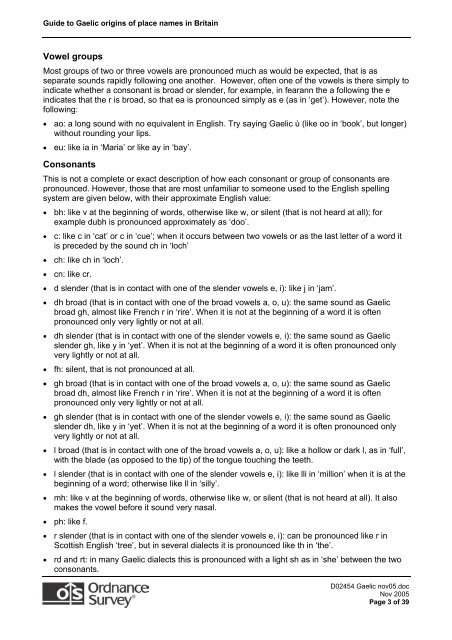guide-to-gaelic-origins-of-place-names
guide-to-gaelic-origins-of-place-names
guide-to-gaelic-origins-of-place-names
You also want an ePaper? Increase the reach of your titles
YUMPU automatically turns print PDFs into web optimized ePapers that Google loves.
Guide <strong>to</strong> Gaelic <strong>origins</strong> <strong>of</strong> <strong>place</strong> <strong>names</strong> in Britain<br />
Vowel groups<br />
Most groups <strong>of</strong> two or three vowels are pronounced much as would be expected, that is as<br />
separate sounds rapidly following one another. However, <strong>of</strong>ten one <strong>of</strong> the vowels is there simply <strong>to</strong><br />
indicate whether a consonant is broad or slender, for example, in fearann the a following the e<br />
indicates that the r is broad, so that ea is pronounced simply as e (as in ‘get’). However, note the<br />
following:<br />
• ao: a long sound with no equivalent in English. Try saying Gaelic ù (like oo in ‘book’, but longer)<br />
without rounding your lips.<br />
• eu: like ia in ‘Maria’ or like ay in ‘bay’.<br />
Consonants<br />
This is not a complete or exact description <strong>of</strong> how each consonant or group <strong>of</strong> consonants are<br />
pronounced. However, those that are most unfamiliar <strong>to</strong> someone used <strong>to</strong> the English spelling<br />
system are given below, with their approximate English value:<br />
• bh: like v at the beginning <strong>of</strong> words, otherwise like w, or silent (that is not heard at all); for<br />
example dubh is pronounced approximately as ‘doo’.<br />
• c: like c in ‘cat’ or c in ‘cue’; when it occurs between two vowels or as the last letter <strong>of</strong> a word it<br />
is preceded by the sound ch in ‘loch’<br />
• ch: like ch in ‘loch’.<br />
• cn: like cr.<br />
• d slender (that is in contact with one <strong>of</strong> the slender vowels e, i): like j in ‘jam’.<br />
• dh broad (that is in contact with one <strong>of</strong> the broad vowels a, o, u): the same sound as Gaelic<br />
broad gh, almost like French r in ‘rire’. When it is not at the beginning <strong>of</strong> a word it is <strong>of</strong>ten<br />
pronounced only very lightly or not at all.<br />
• dh slender (that is in contact with one <strong>of</strong> the slender vowels e, i): the same sound as Gaelic<br />
slender gh, like y in ‘yet’. When it is not at the beginning <strong>of</strong> a word it is <strong>of</strong>ten pronounced only<br />
very lightly or not at all.<br />
• fh: silent, that is not pronounced at all.<br />
• gh broad (that is in contact with one <strong>of</strong> the broad vowels a, o, u): the same sound as Gaelic<br />
broad dh, almost like French r in ‘rire’. When it is not at the beginning <strong>of</strong> a word it is <strong>of</strong>ten<br />
pronounced only very lightly or not at all.<br />
• gh slender (that is in contact with one <strong>of</strong> the slender vowels e, i): the same sound as Gaelic<br />
slender dh, like y in ‘yet’. When it is not at the beginning <strong>of</strong> a word it is <strong>of</strong>ten pronounced only<br />
very lightly or not at all.<br />
• l broad (that is in contact with one <strong>of</strong> the broad vowels a, o, u): like a hollow or dark l, as in ‘full’,<br />
with the blade (as opposed <strong>to</strong> the tip) <strong>of</strong> the <strong>to</strong>ngue <strong>to</strong>uching the teeth.<br />
• l slender (that is in contact with one <strong>of</strong> the slender vowels e, i): like lli in ‘million’ when it is at the<br />
beginning <strong>of</strong> a word; otherwise like ll in ‘silly’.<br />
• mh: like v at the beginning <strong>of</strong> words, otherwise like w, or silent (that is not heard at all). It also<br />
makes the vowel before it sound very nasal.<br />
• ph: like f.<br />
• r slender (that is in contact with one <strong>of</strong> the slender vowels e, i): can be pronounced like r in<br />
Scottish English ‘tree’, but in several dialects it is pronounced like th in ‘the’.<br />
• rd and rt: in many Gaelic dialects this is pronounced with a light sh as in ‘she’ between the two<br />
consonants.<br />
D02454 Gaelic nov05.doc<br />
Nov 2005<br />
Page 3 <strong>of</strong> 39


